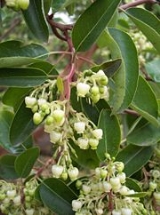
Arbutus andrachne
Encyclopedia
Arbutus andrachne, commonly called the Greek Strawberry Tree, is an evergreen shrub
or small tree
in the family Ericaceae
, native to the Mediterranean region, the Middle East
, and southwestern Asia.
's extensive botanical garden and greenhouses at Upton House, Essex (now West Ham Park
), in 1765.
Shrub
A shrub or bush is distinguished from a tree by its multiple stems and shorter height, usually under 5–6 m tall. A large number of plants may become either shrubs or trees, depending on the growing conditions they experience...
or small tree
Tree
A tree is a perennial woody plant. It is most often defined as a woody plant that has many secondary branches supported clear of the ground on a single main stem or trunk with clear apical dominance. A minimum height specification at maturity is cited by some authors, varying from 3 m to...
in the family Ericaceae
Ericaceae
The Ericaceae, commonly known as the heath or heather family, is a group of mostly calcifuge flowering plants. The family is large, with roughly 4000 species spread across 126 genera, making it the 14th most speciose family of flowering plants...
, native to the Mediterranean region, the Middle East
Middle East
The Middle East is a region that encompasses Western Asia and Northern Africa. It is often used as a synonym for Near East, in opposition to Far East...
, and southwestern Asia.
Garden history
Arbutus andrachne was reported by Peter Collinson as having flowered first in England in Dr John FothergillJohn Fothergill (physician)
John Fothergill FRS was an English physician, plant collector, philanthropist and Quaker.- Life and work :...
's extensive botanical garden and greenhouses at Upton House, Essex (now West Ham Park
West Ham Park
West Ham Park is a public park in the London Borough of Newham. Spanning , the park has been managed by the City of London Corporation since 1874. Previously it was the grounds of Ham House, owned by the Gurney family and demolished in 1872...
), in 1765.
In literature
' There was on the road a small tree bearing a fruit somewhat bigger than our largest cherries, and of the shape and taste of strawberries, but a little acid. It is pleasant to eat; but, if a great quantity be eaten, it mounts to the head, and intoxicates. It is ripe in November and December. '
[...] " From the description, it seems to be the arbutus Andrachne[ sicSicSic—generally inside square brackets, [sic], and occasionally parentheses, —when added just after a quote or reprinted text, indicates the passage appears exactly as in the original source...] ..."

